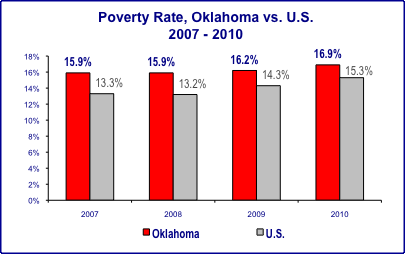Update: Click here for our 2010 Poverty Profile based on the Census Bureau data
Despite Oklahoma’s comparatively modest unemployment rate and steady wage growth over the last two years, many of the state’s low income residents continue to be left behind by the economic recovery. According to data released today by the Census Bureau, the state’s individual poverty rate rose from 16.2 percent in 2009 to 16.9 percent in 2010. There were 616,610 people living in poverty in 2010 – about one in six Oklahomans. A family of four is below the poverty level if they earn less than $22,113 a year. The chart below shows state and national poverty rates over the last four years:
Oklahoma’s poverty rate is up .7 percentage points from last year and 1 percentage point since 2007. The national poverty rate is rising faster than the state rate, up 1 percentage point from last year and 2 percentage points since 2007. Compared to the rest of the country, Oklahoma has the 14th highest poverty rate among individuals.
The largest one-year increase in poverty occurred among children, which rose from 22.2 percent in 2009 to 24.5 percent in 2010. Nearly one in four Oklahoma children now live in poverty. This chart displays the state poverty rate by age from 2009 to 2010:
Racial and ethnic disparities in poverty remained unchanged in 2010, with every minority group seeing higher levels of poverty than their white counterparts. The poverty rate among African American’s (30.1 percent) in Oklahoma is more than twice that of whites (13.9 percent).
While the poverty rate in Tulsa rose from 19.5 to 20.1 percent, Oklahoma City was the only city in the Census survey to see a decline in poverty in 2010. The poverty rate in Oklahoma City dropped by 1.3 percentage points, from 18.1 to 16.8 percent between 2009 and 2010. The new poverty data was front page news in this morning’s Tulsa World, which discussed poverty in the context of continuing unemployment and lack of health insurance coverage. OK Policy Director David Blatt described current trends as “pretty distressing” and highlighted the partial nature of Oklahoma’s economic recovery:
Even though we have seen some encouraging economic signs over the last 12 months, we are dealing with a very partial recovery, which is not extended throughout the population. So we continue to see large numbers of people who are struggling to find work.
In addition to rising poverty, Oklahoma continues to experience increased demand for social services. Participation in the SNAP program (formerly food stamps) rose to more than 614,000 people in July 2011. Howard Hendrick, director of the Department of Human Services noted in August:
This is the highest average monthly SNAP participation in the history of the state. We’re up 45 percent from where we were three years ago.
These data show that despite experiencing a comparatively less severe recession than most other states, the situation for those at the bottom in Oklahoma is more fragile than ever. For thousands of families living in poverty, it’s a struggle to pay even basic household expenses, and social services like the food stamp program are crucial to their well-being. We cannot lose sight of our poorest and most vulnerable residents in the coming months and years, even as economic indicators bring welcome news of continued improvement overall.





 OKPOLICY.ORG
OKPOLICY.ORG



I just wonder whether the poverty line of 22k is or should be adjusted based on cost of living differences between the various states. Not to say that rate of change is not significant, but for accurate comparison purposes, the difference in cost of living should be considered.